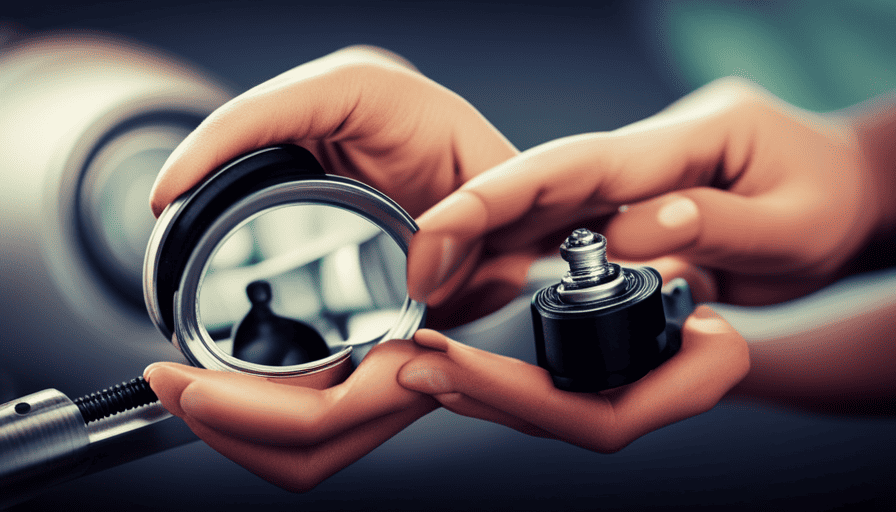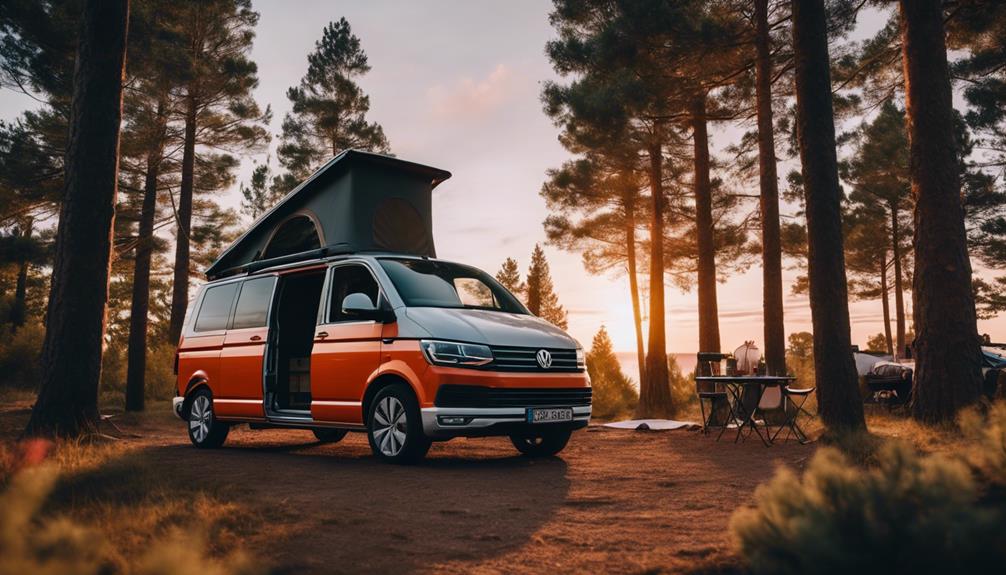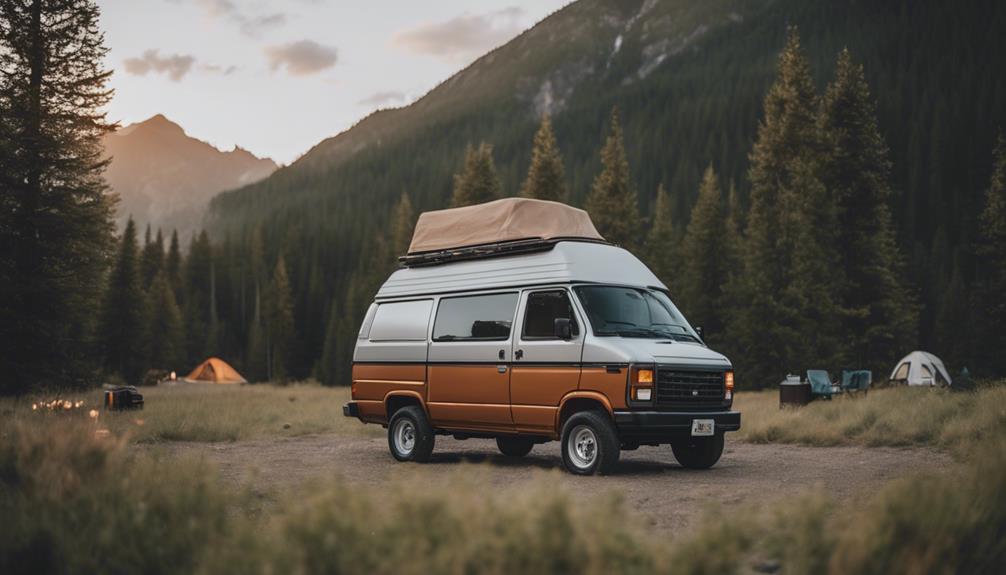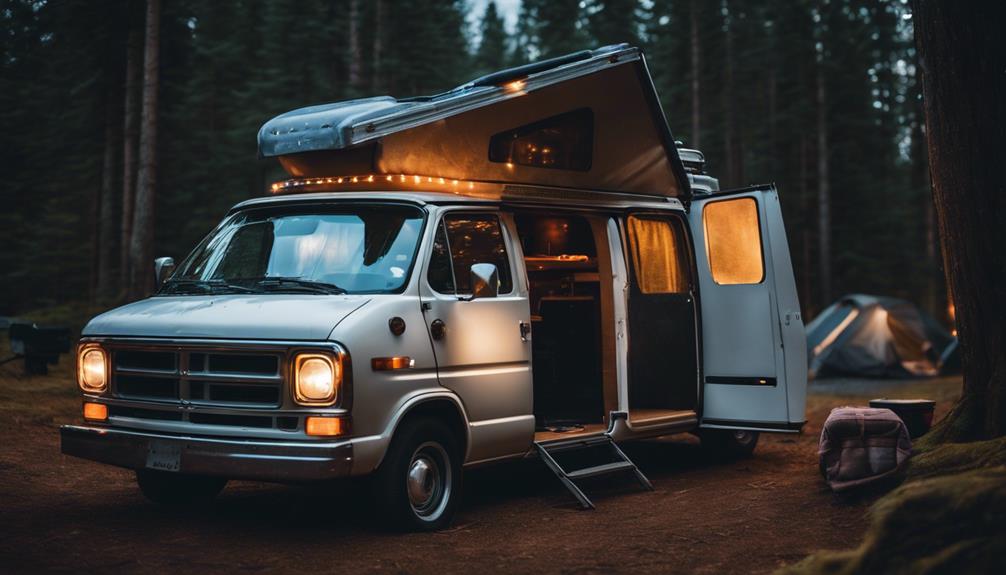As they say, “Home is where you park it.” For those who enjoy the freedom of the open road, our campers become our comfortable homes. But what do you do when you’re in a remote location and in need of a hot shower? Don’t worry, fellow campers, we have the answer for you – installing a propane water heater in your camper.
In this article, we will guide you through the precise steps to get that hot water flowing. From gathering the necessary materials to ensuring proper ventilation, locating the water heater, preparing the propane tank, igniting the water heater, and waiting for the water to heat, we’ve got you covered. We’ll even walk you through testing the hot water and provide essential safety precautions.
So, let’s dive in and make your camping experience even more enjoyable with a steaming hot shower on demand.
Key Takeaways
- Proper ventilation is essential before starting the propane water heater to prevent the buildup of harmful gases like carbon monoxide.
- Ensure the propane tank is not empty and securely connected to the camper’s propane system.
- Use caution when handling and connecting the propane tank, being careful not to damage the fittings.
- Follow the manufacturer’s instructions and guidelines for operation, and regularly inspect the water heater for damage or leaks.
Gather the necessary materials
Before you can start a propane water heater in your camper, it’s important to gather all of the necessary materials. Proper camper water heater maintenance is essential for a safe and efficient operation.
To begin, make sure you have the following items on hand: a propane tank, a propane hose, a propane regulator, a wrench, and a lighter or matches. These materials will enable you to troubleshoot any issues that may arise during the startup process.
Start by checking the propane tank to ensure it isn’t empty. Connect the propane hose to the tank and the other end to the propane regulator. Use a wrench to tighten the connections securely.
Next, turn the propane tank’s valve to the on position. This will allow propane to flow through the hose and into the water heater.
Once the propane is flowing, locate the water heater’s pilot light. Consult the manufacturer’s instructions to determine the exact location. Use a lighter or matches to ignite the pilot light. Hold the flame near the pilot light until it ignites. Once the pilot light is lit, you can adjust the temperature settings as desired.
Ensure proper ventilation by opening any necessary vents or windows. This will allow for the escape of any potentially harmful gases.
With all materials gathered and the water heater successfully started, you can now enjoy hot water in your camper.
Ensure proper ventilation
To ensure adequate ventilation, make sure you’ve properly set up the air circulation system in your recreational vehicle. Proper ventilation is crucial when starting a propane water heater in a camper as it ensures the safe and efficient operation of the appliance.
Adequate airflow is necessary to prevent the buildup of harmful gases, like carbon monoxide, which could lead to serious health risks.
One common ventilation problem is improper installation or blockage of the ventilation system. Ensure that all vents and exhaust pipes are clear from any debris or obstructions. Regularly check and clean the ventilation system to maintain its optimal functioning.
Another common issue is inadequate ventilation in the camper. Ensure that there are enough vents or windows open to allow fresh air to circulate and exhaust the combustion gases properly.
It’s important to note that a properly functioning ventilation system should be in place before attempting to start the propane water heater. Once you’ve ensured proper ventilation, you can move on to the next step of turning off all electrical devices to avoid any potential hazards. This’ll help create a safe environment for starting the propane water heater in your camper.
Turn off all electrical devices
Make sure you shut down all electronic devices and gadgets in your recreational vehicle to create a calm and peaceful ambiance before proceeding.
Before starting a propane water heater in your camper, it’s crucial to check the electrical system to ensure everything’s properly turned off. This step is of utmost importance as not doing so can lead to potential dangers and accidents.
When electrical devices are left on, they consume power and generate heat. This heat buildup can be hazardous when combined with a propane water heater. The excess heat can overload the electrical system, causing circuit breakers to trip or fuses to blow. This can result in power outages or even electrical fires, putting your safety at risk.
Furthermore, leaving electronic devices on can drain the camper’s battery, which is essential for operating the water heater. Insufficient power can prevent the heater from functioning correctly, leading to inconsistent heating or no hot water at all.
To avoid these potential dangers, it’s crucial to turn off all electrical devices and gadgets in your camper before starting the propane water heater. This ensures a safe and efficient operation of the water heater.
Now, let’s move on to the next step and locate the water heater in your camper.
Locate the water heater
As you explore your recreational vehicle, you’ll soon come across the cozy nook where the water heater is tucked away. Proper water heater maintenance is crucial for a consistently reliable supply of hot water during your camping adventures. To ensure optimal performance, it’s essential to familiarize yourself with water heater troubleshooting techniques.
When it comes to water heater maintenance, there are a few key aspects to keep in mind. First, regularly inspect the exterior of the water heater for any signs of damage or corrosion. Additionally, check the pressure relief valve for proper functionality and ensure it’s not leaking. Lastly, flush the tank annually to remove sediments that can hinder its efficiency.
To troubleshoot common water heater issues, you should consider the following sub-lists:
-
No hot water:
- Check the pilot light and ensure it’s lit.
- Verify that the gas supply valve is open.
- Inspect the thermocouple for any signs of damage.
-
Inadequate hot water:
- Adjust the temperature setting to a higher value.
- Insulate the water heater and pipes to minimize heat loss.
- Examine the dip tube for any blockages.
-
Leaking water:
- Check all fittings and connections for tightness.
- Replace any faulty valves or gaskets.
- Inspect the tank for cracks or leaks.
By diligently performing water heater maintenance and troubleshooting, you’ll be well-prepared to enjoy a steady supply of hot water during your camping trips. As we move on to the next section, let’s prepare the propane tank for the water heater ignition.
Prepare the propane tank
Get ready to ignite your cozy camping oasis by preparing the tank of flammable gas that’ll fuel your warm water supply. Proper propane tank maintenance is essential to ensure a safe and efficient operation of your water heater.
Before starting, it’s important to inspect the tank for any signs of damage, such as dents or corrosion. Ensure that the tank is securely fastened in its designated compartment and that all connections are tight and leak-free.
To guarantee propane tank safety, always handle the tank with care and never expose it to extreme heat or open flames. Keep it in a well-ventilated area and away from any sources of ignition. It’s crucial to keep the tank upright at all times, as tilting or laying it on its side can cause gas leaks or damage the tank.
Additionally, check the tank’s pressure gauge regularly to ensure it’s within the safe range. If the pressure is too low, the water heater may not function properly. If you notice any abnormalities, such as a strong odor of gas or hissing sounds, immediately turn off the tank’s valve and consult a professional.
With the propane tank properly maintained and checked for safety, we can now move on to the next step of turning on the propane supply and getting your water heater up and running efficiently.
Turn on the propane supply
To ignite your cozy camping oasis, it’s time to fire up the propane supply and bring your warm water supply to life. Before you get started, it’s crucial to prioritize propane safety and ensure proper propane tank maintenance. Follow these steps to get your propane water heater in your camper up and running smoothly:
-
Inspect the propane tank: Check for any signs of damage or leaks. Look for rust, dents, or loose fittings. If you notice any issues, don’t attempt to use the tank and seek professional assistance.
-
Securely attach the propane tank: Make sure the tank is tightly connected to the camper’s propane system. Use a wrench to tighten the fittings, but be careful not to overtighten and risk damaging them.
-
Open the propane tank valve: Slowly turn the valve counterclockwise to release the propane gas. Listen for the sound of gas flowing and make sure there are no noticeable leaks.
-
Check for leaks: Apply a mixture of soapy water to the connections and observe for any bubbles. If bubbles form, tighten the connection or seek professional help.
-
Close the propane tank valve: Once you’ve confirmed there are no leaks, close the valve by turning it clockwise until it’s firmly closed.
With the propane supply now activated, it’s time to ignite the water heater and enjoy a warm and comfortable camping experience.
Ignite the water heater
Light the spark of warmth in your cozy camping oasis by igniting the fiery embrace of your water heater, allowing it to dance with the flames and bring comfort to your wilderness retreat. To ignite the water heater, follow these troubleshooting tips and maintenance checklist to ensure a seamless start-up process.
First, locate the control panel on your water heater. It should be near the bottom of the unit. Turn the gas control knob to the ‘Off’ position if it isn’t already. This step is crucial for safety reasons.
Next, locate the pilot light assembly. It’s usually located near the bottom of the water heater. Open the access panel to reveal the assembly. Turn the gas control knob to the ‘Pilot’ position and press it down. This’ll allow gas to flow to the pilot light.
With a long lighter or match, carefully light the pilot light. Keep the gas control knob pressed down for about 30 seconds to allow the thermocouple to heat up and sense the flame. Release the knob and the pilot light should stay lit.
Close the access panel and turn the gas control knob to the desired temperature. Now, wait for the water to heat up, transforming your camper into a haven of warmth and relaxation.
Transitioning to the subsequent section about ‘wait for the water to heat,’ make sure you’ve followed the proper steps to ignite your water heater.
Wait for the water to heat
Now that the fiery dance of your water heater has begun, you can sit back and eagerly anticipate the soothing warmth that will soon envelop your cozy oasis in the wilderness. However, it’s important to remember that the waiting time for the water to heat may vary depending on various factors such as the size of your camper and the initial temperature of the water.
On average, it takes about 10 to 15 minutes for the water to reach its desired temperature.
During this waiting time, you may encounter some common troubleshooting tips. If you notice that the water is taking longer than usual to heat up, check if the propane tank is properly connected and has enough fuel. Additionally, make sure that the water heater’s pilot light is on and functioning properly. If the pilot light is out, follow the manufacturer’s instructions to relight it.
As you patiently wait for the water to heat, take this opportunity to prepare yourself for a relaxing shower or to wash your dishes with warm water.
In the next section, we’ll discuss how to test the hot water to ensure it reaches the desired temperature.
Test the hot water
Imagine the sheer delight as you dip your hand into the flowing stream and feel the scalding hot water that could rival the depths of hell itself. Before fully enjoying this blissful moment, it’s crucial to test the hot water in your propane water heater in the camper. Checking the water pressure is the first step in ensuring a satisfying shower experience.
Start by turning on the hot water faucet and observing the flow. If the water pressure seems low, you may need to adjust the pressure regulator accordingly.
Next, it’s time to adjust the temperature to your desired level. Locate the temperature control knob, usually found near the water heater, and turn it clockwise to increase the temperature or counterclockwise to decrease it. Be cautious not to set the temperature too high, as scalding can occur.
Once you have achieved the perfect balance of pressure and temperature, you can proceed with your shower. However, before doing so, it’s important to take certain safety precautions to prevent accidents. [Transition to the subsequent section about safety precautions.]
Safety precautions
To ensure your safety during your shower, it’s vital that you take appropriate precautions. When operating a propane water heater in your camper, it’s important to have a fire extinguisher readily available. This will allow you to quickly and effectively extinguish any potential fires that may occur. Make sure the fire extinguisher is properly charged and easily accessible in case of an emergency.
Additionally, it’s crucial to have a carbon monoxide detector installed in your camper. Propane water heaters produce carbon monoxide as a byproduct of combustion, and this gas can be deadly if not detected early. Install a carbon monoxide detector near the water heater and regularly check its functionality to ensure your safety.
Before starting the propane water heater, thoroughly inspect the unit for any signs of damage or leaks. Look for cracks, loose connections, or unusual smells that may indicate a problem. If any issues are found, don’t attempt to start the water heater and seek professional assistance.
When operating the propane water heater, always follow the manufacturer’s instructions and guidelines. Ensure proper ventilation by keeping windows or vents open while the heater is in use. Never leave the water heater unattended and always turn it off when not in use.
By following these safety precautions, you can enjoy a hot shower in your camper with peace of mind, knowing that you’ve taken the necessary steps to protect yourself from potential hazards.
Frequently Asked Questions
How often should I check the ventilation system in my camper to ensure it is functioning properly?
To ensure the proper functioning of the ventilation system in your camper’s water heater, it’s crucial to perform regular checks. Here are some tips for maintaining the ventilation system:
- Firstly, inspect the vents and chimney for any signs of blockages or debris accumulation.
- Secondly, check the exhaust fan to make sure it’s running smoothly.
- Additionally, examine the air intake to verify it’s clear and unobstructed.
- Lastly, be vigilant for any unusual smells, noises, or inadequate heat output, as these may indicate ventilation issues.
Regular inspection and troubleshooting will help avoid potential hazards and ensure optimal performance.
Can I use any type of propane tank for my camper water heater, or are there specific requirements?
Using the wrong propane tank for your camper water heater can be dangerous. It’s crucial to follow specific propane tank requirements to ensure proper functionality and safety.
Additionally, regular maintenance of the ventilation system is vital to prevent any potential issues. By adhering to the correct propane tank specifications and conducting routine ventilation maintenance, you can guarantee the efficient and secure operation of your camper water heater.
Are there any specific safety precautions I should take when igniting the water heater?
When igniting a water heater in a camper, there are specific safety precautions that should be followed. Firstly, proper ventilation maintenance is crucial to prevent the buildup of harmful gases. Ensure that the area is well-ventilated before starting the heater.
Secondly, it’s important to use a propane tank that meets the proper requirements for your water heater. Check the manufacturer’s guidelines to ensure the tank is compatible and in good condition.
How long does it typically take for the water to heat up after turning on the propane supply?
Water heating time and propane efficiency are important factors to consider when operating a propane water heater. The time it takes for the water to heat up after turning on the propane supply can vary depending on several factors such as the initial temperature of the water and the heater’s capacity. However, on average, it typically takes around 30 minutes to an hour for the water to reach the desired temperature. The propane efficiency of the heater also plays a role in the heating time. Higher efficiency heaters tend to heat the water more quickly.
Is there a recommended temperature range for testing the hot water to ensure it is at the desired temperature?
When testing the hot water in a propane water heater, it’s important to ensure that it’s at the desired temperature. The recommended temperature range for testing the hot water is typically between 120°F and 140°F. This range ensures that the water is hot enough for most purposes, while still being safe to use.
It’s important to always follow propane water heater safety precautions, such as checking for leaks and ensuring proper ventilation, when using a propane water heater.
Conclusion
As we stand by the newly ignited propane water heater, we can’t help but feel a sense of accomplishment and comfort. The gentle hum of the heater symbolizes warmth and security, reminding us of the cozy nights ahead.
With meticulous preparation and adherence to safety precautions, we’ve successfully embarked on our journey towards a relaxing camping experience. The hot water gushing from the faucet serves as a reminder that we’ve conquered yet another challenge, bringing us closer to the serenity and tranquility of nature.










